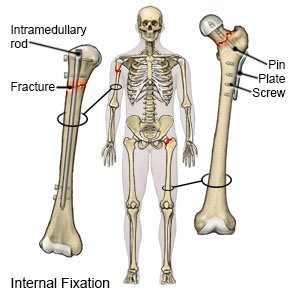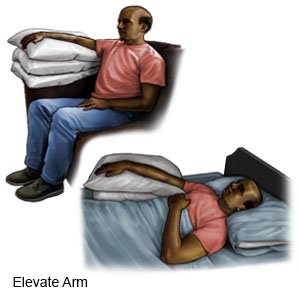ORIF of a Wrist Fracture
Medically reviewed by Drugs.com. Last updated on Aug 4, 2025.
Open reduction and internal fixation (ORIF) of a wrist fracture is surgery to fix a broken wrist. Open reduction means that the bone is moved back into the right place with surgery. Internal fixation means that hardware (such as screws, rods, or pins) is used to hold the broken bones together.
 |
DISCHARGE INSTRUCTIONS:
Call your local emergency number (911 in the US) for any of the following:
- You suddenly feel lightheaded and short of breath.
- You have chest pain when you take a deep breath or cough. You cough up blood.
Seek care immediately if:
- Your arm or leg feels warm, tender, and painful. It may look swollen and red.
- Your incision is red, swollen, or draining pus.
- Your fingers look pale or blue, feel numb, or tingle.
- Blood soaks through your bandage.
Call your doctor or surgeon if:
- Your cast or splint breaks or gets damaged.
- You have severe pain, even after you take pain medicine.
- You have a fever.
- You have questions or concerns about your condition or care.
Medicines:
- Prescription pain medicine may be given. Ask your healthcare provider how to take this medicine safely. Some prescription pain medicines contain acetaminophen. Do not take other medicines that contain acetaminophen without talking to your healthcare provider. Too much acetaminophen may cause liver damage. Prescription pain medicine may cause constipation. Ask your healthcare provider how to prevent or treat constipation.
- Take your medicine as directed. Contact your healthcare provider if you think your medicine is not helping or if you have side effects. Tell your provider if you are allergic to any medicine. Keep a list of the medicines, vitamins, and herbs you take. Include the amounts, and when and why you take them. Bring the list or the pill bottles to follow-up visits. Carry your medicine list with you in case of an emergency.
Self-care:
- Apply ice as directed. Ice helps prevent tissue damage and decreases swelling and pain. Apply ice on your wrist for 15 to 20 minutes every hour or as directed. Use an ice pack, or put crushed ice in a plastic bag. Cover it with a towel before you apply it to your wrist.
- Elevate your wrist. Keep your wrist above the level of your heart as often as you can. This will help decrease swelling and pain. Prop your wrist on pillows or blankets to keep it elevated comfortably.

- Care for your splint or cast as directed. Ask when you can bathe. Follow your healthcare provider's directions for bathing with a splint or cast. Wrap a plastic bag around your wrist. Tape the bag closed so water will not get in while you bathe.
- Ask when you can return to your normal daily activities. You may need to avoid lifting objects that are heavier than 5 pounds. Your healthcare provider may recommend that you exercise your fingers and arm. He or she will give you exercises to do.
Follow up with your doctor or surgeon as directed:
You will need to return to have your wound checked and stitches or staples removed. Write down your questions so you remember to ask them during your visits.
© Copyright Merative 2025 Information is for End User's use only and may not be sold, redistributed or otherwise used for commercial purposes.
The above information is an educational aid only. It is not intended as medical advice for individual conditions or treatments. Talk to your doctor, nurse or pharmacist before following any medical regimen to see if it is safe and effective for you.
Further information
Always consult your healthcare provider to ensure the information displayed on this page applies to your personal circumstances.
